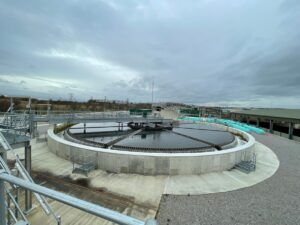Xylem Helps Understanding PFAS Treatment Technologies
What are PFAS and why are they harmful?
Per- and polyfluoroalkyl substances (PFAS) are a group of man-made chemicals widely used in various industrial and consumer products due to their resistance to water, oil, and heat. These substances have been used in products like non-stick cookware, water-repellent clothing, firefighting foams, and food packaging.
PFAS are highly persistent in the environment and human body, which is why they are often referred to as "forever chemicals." Due to their widespread use and longevity, PFAS have become a significant contaminant in water sources, leading to concerns about their impact on human health, including potential links to cancer, hormone disruption, and immune system effects.
How pervasive are PFAS in the environment?
PFAS are extremely pervasive in the environment due to their widespread use and remarkable persistence. They have been detected in air, soil, and water bodies across the globe, including in remote areas far from any known source of contamination. PFAS have also been found in the blood of humans and wildlife, indicating widespread exposure.
Their resistance to natural degradation processes means that once released into the environment, PFAS can persist for decades, accumulating in ecosystems and moving through the food chain.
This widespread contamination has made PFAS a significant environmental and public health concern, prompting increased efforts to monitor, regulate, and develop technologies for PFAS treatment.
Why do utilities need to prioritize PFAS treatment?
Utilities must prioritize PFAS treatment to protect communities and comply with increasingly strict PFAS regulations for drinking water. In April 2024, the Biden-Harris Administration established the first-ever national, enforceable drinking water standard for PFAS, aiming to reduce exposure for approximately 100 million Americans. Global regulations on PFAS treatment are also tightening. In the European Union, new rules limit PFAS levels in drinking water, with compliance required from Member States by 2026.
Traditional water treatment methods, such as coagulation and chlorination, are ineffective for PFAS treatment. To meet stricter PFAS regulations, water utilities can leverage existing PFAS treatment technologies, such as granular activated carbon, reverse osmosis, and ion exchange systems. Water utilities should begin testing and monitoring for PFAS now, so they can upgrade their infrastructure in time to meet upcoming PFAS limits.
What different types of PFAS are there?
PFAS include a broad range of chemicals, often categorized into two main groups: long-chain and short-chain PFAS.
Long-chain PFAS: Include substances like perfluorooctanoic acid (PFOA) and perfluorooctanesulfonic acid (PFOS), which have been widely used in industrial applications and consumer products.
Short-chain PFAS: Include substances such as perfluorobutanesulfonic acid (PFBS) and perfluorobutanoic acid (PFBA). Developed as alternatives to long-chain PFAS, these substances still pose environmental and health concerns despite their lower accumulation in organisms.
PFAS treatment technologies for drinking water
PFAS treatment technologies for drinking water primarily include activated carbon filtration, ion exchange, advanced liquid phase adsorption systems, and reverse osmosis:
Activated carbon filtration: This PFAS treatment method, particularly using granular activated carbon (GAC), is widely used due to its ability to adsorb PFAS from water, effectively capturing these compounds on the surface of the carbon material.
Ion exchange resins: In this common PFAS treatment technology, the resins exchange harmful PFAS ions in the water with harmless ones, reducing PFAS concentration.
Advanced liquid phase adsorption systems: These systems for PFAS treatment may use a variety of specialized adsorbents, including ion exchange resins, synthetic polymers, or specially engineered carbons, tailored to target specific contaminants.
Reverse osmosis: This PFAS treatment method, involving a high-pressure membrane filtration process, is highly effective in removing PFAS by filtering water through a semipermeable membrane that blocks PFAS molecules and allowing clean water to pass through.
PFAS treatment recommendations for water utilities
Assess water sources and PFAS types: Water utilities looking to implement effective PFAS treatment strategies should begin by thoroughly assessing their water sources to identify the presence and concentration of PFAS compounds. This includes conducting detailed water quality testing to determine the specific types of PFAS present and their levels relative to regulatory standards.
Selecting the optimal PFAS treatment technology: Once the contamination is understood, utilities should explore proven PFAS treatment technologies such as granular activated carbon (GAC) filtration, ion exchange resins, or advanced liquid phase adsorption systems.
It’s crucial to select the technology best suited to the local water chemistry and treatment goals, possibly starting with a pilot test to confirm the effectiveness of the chosen method.
Regular monitoring and maintenance: In addition to selecting the appropriate PFAS treatment technology, utilities should develop a comprehensive plan that includes regular monitoring and maintenance to ensure ongoing compliance with current regulations. This plan should also account for potential changes in PFAS regulations, which are becoming increasingly stringent.
Choose the right partner for PFAS treatment: Collaborating with experienced partners like Xylem can provide utilities with access to the latest PFAS treatment technologies and expert guidance on system design, implementation, and long-term operation. By taking these steps, water utilities can effectively protect their communities and customers from PFAS contamination while ensuring compliance with evolving regulatory requirements.
Xylem’s proven technologies for PFAS treatment
Xylem offers a diverse range of PFAS treatment solutions tailored to various industries, including municipal drinking water systems, industrial wastewater treatment, and construction dewatering.
Municipalities: Xylem provides technologies like granular activated carbon (GAC) filtration, ion exchange resins, and advanced liquid phase media adsorption systems to ensure that communities receive safe, clean water that meets regulatory standards. These solutions are available as both permanent installations and emergency PFAS treatment mobile units, making them adaptable to different water chemistries and urgent needs.
Industrial and commercial settings: Xylem’s PFAS treatment technologies are crucial for treating wastewater and contaminated groundwater. Our mobile filtration systems are particularly effective for construction projects, quickly reducing PFAS levels to non-detectable levels, ensuring compliance, and allowing safe water discharge.
Specialized solutions: Xylem offers specialized PFAS treatment solutions for airports and military bases, addressing PFAS contamination from firefighting foams through both groundwater and soil remediation. Our technology-agnostic approach ensures that the most effective PFAS treatment methods are selected for each specific application.
Source: Xylem Inc.





